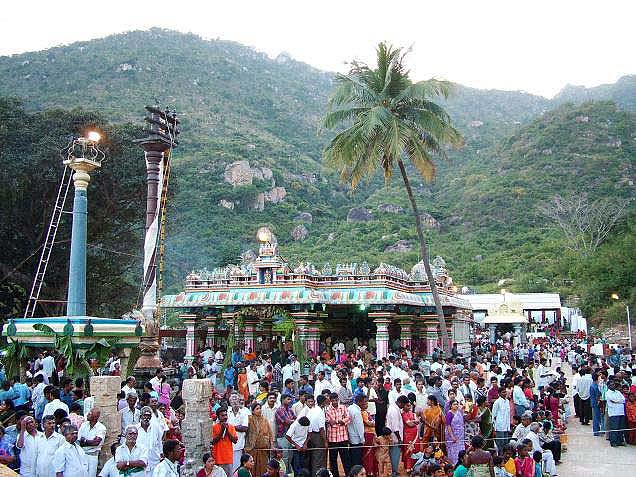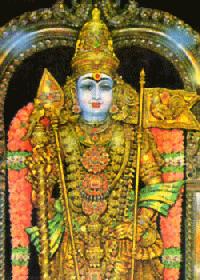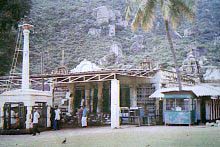
|
|||||||||||||||||||||||||
|
| |||||||||||||||||||||||||
Marudhamalai Murugan Temple
Fifteen kilometers west of Coimbatore, on the Western Ghats, situated in a lush, green milieu is the temple of Marudhamalai. Said to belong to the 12th Century, the temple is surrounded by the hilly range on three sides. Several buses ply between Coimbatore and the foothills of Marudhamalai, from where devotees board mini buses to reach the temple. Stone inscriptions dating back to the 12th Century contain words such as Marudhan and Marudhachalam, which reveal that the names were in vogue even then. Marudhamalai abounds in medicinal herbs and the pure air and serene atmosphere should make it a haven for the health-conscious. The hill is dotted with small mandapams for the devotees to relax on their way uphill. At the foothills, where the steps to the temple begin, is the Thaan Thondri Vinayakar Temple. The 18th step above the Vinayakar Temple is another significant spot because those, who are unable to make it to Sabarimala find praying at this place equally gratifying. Another deity that draws your attention on the way is Idumban, who is seen on a huge circular rock at the Temple of Idumban! The three huge stones that stand out for the colour that’s different from the rest, and the mandapam of Kudhirai Kulambu are the other noticeable places on the route. High above these are the Paambaatti Siddhar Cave, Uchchi Pillaiyar Temple and Pancha Vriksham that convey a lot about the hoariness of Marudhamalai. The Adi Moolasthanam is in the shape of a lingam, where Lord Muruga is seen with Valli and Deivanai. The beautiful deity of Muruga in the Moolasthanam is both a devotee's and connoisseur's delight! Noted yesteryear filmmaker M.M.A. Chinnappa Thevar made an immense contribution to the proper maintenance of the temple, clearing the hilly route for devotees to climb up easily, building resting houses, providing lights on the path to the temple and so on. Water has been provided at the hill at a cost of more than Rs. 6 lakhs. Apart from religious activities, serving society is part of the agenda. The temple manages a home for destitutes, where now 45 children benefit. Besides food, clothing and shelter, the temple takes care of their education till the high school level. At the foot of the hill, a siddha hospital treats the poor and distributes medicines worth Rs. 30,000 free, annually. In Vadavalli, the temple management also runs a school, which had initially been functioning under a thatched roof. It has now shifted to a permanent structure and has grown into a high school. Courtesy: The Hindu of August 26, 2010 LocationMarudhamalai Hills Arulmigu Subramanyaswamy Temple is situated at a height of about 500 feet in a plateau on the Western Ghats, fifteen kilometers north west of Coimbatore, amidst lush vegetation and salubrious climate. The city of Coimbatore is well linked to the capital of Tamil Nadu, Chennai by road, rail and air. From Coimbatore bus stand many city buses ply to Marudhamalai. The Devasthanam has provided 3 buses from the foothill to reach the temple on top. Several amenities and facilities have been provided for the benefit of the devotees to worship the deity. A good motorable road has been laid upto the hilltop by the Temple Devasthanam. FacilitiesThis is by all means a great boon to the physically handicapped who cannot climb the steps. There are three mini buses run by the Devasthanam, plying to and fro in quick succession at a very nominal charge for the benefit of the devotees. The Ghat Road is also electrified. At dusk, it is a varietable feast to the eye to stand far away from the hills and gaze at the illumination spiraling like stars strung together in the sky.
On the hilltop there is a wedding hall for celebrating marriage and at the foothill, there is a rest house, called Marudham which has twelve rooms provided with excellent amenities for stay and worship. Nearby Tourist Spots:
HillMarudhamalai Hills, dedicated to Lord Muruga (Dandāyudhapāni) is classified under Kunruthoradal, one of the six main abodes of the god. Set against the backdrop of hazy blue hills dotted with shrubs and bushes of varied hues, the sacred shrine verily reflects the picture of Lord Muruga, magnificently mounted on his vehicle peacock, flaunting and swaying its feathers and plume in full bloom. The Sanskrit word "achalam" denotes mountain. As the mountain here abounded in marudham trees, it came to be known as Marudhachalam. Marudhamalai is also called Marundhumalai, for it is overgrown with shrubs and bushes of medicinal properties. Hence, Marudhamalai is befittingly given the name Marudhamalai (Mountain of Medicines). This is referred to as Marudhamalvarai, Marudhavarai, Marudha Verpu, Marudha Kundru, Marudhavōngal, Kamarpirangu, Marudhachalam, Velvarai in Perur Puranam. Special FeaturesThe holy shrine of Marudhamalai is believed to remove both physical and mental afflictions and attachments as the hill abounds in Medicinal herbs. The pleasant breeze and the peaceful environments bring harmony and quietness to the minds of devotees. The saints and holymen used to prefer this hill and came here in search of 'KayaKalpam' the Divine medicine for Salvation. The celestial cow 'Kamadhenu' is believed to have grazed in the pastures of this hillock and drunk from the springs under the Marudham tree as per Perur Puranam written by Kachiappa Munivar. Temple
|
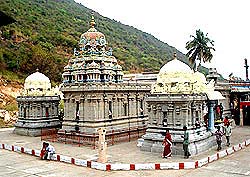 |
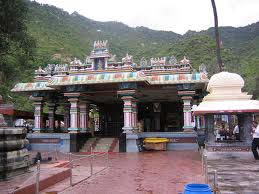 |
Mythology
Perur puranam lists the three neighboring hills, Vellingiri, Nili and Marudhamalai as the very manifestations of Lord Siva, Parvati and Subramanya respectively and the three hills taken together as the very symbol of Somaskanda. A siddha, overcome by excessive tiredness and thirst, sought shelter under the shade of a marudham tree and prayed for the mercy of Lord Muruga for a shower of water, which sprang at once, as though by a miracle from the tree.
As water gushed out from the roots of the marudham tree, the siddha jumped in joy, glorifying Muruga as the Lord of Marudham and jalam (water). With the passage of time, Marudhajalapati became Marudhachalapati.
According to Perur Puranam, Surapadma, the scourge of the gods, aided by his mighty brothers Singamukha and Taraka arrayed against them and struck terror in their already agitated minds by his sudden and surprising charges and depredations. Unable to bear the agony and anguish, the gods approached Lord Siva and sought His succour.
Lord siva comforted the gods that Lord Muruga would come to their rescue, root out and destroy Surapadma and his retinue enmasse. The gods should hasten to the Marudhamalai Hills and await the advent of Lord Muruga, their Saviour! Perur Puranam also alludes to a king called Kusathvajan, who it is said, was blessed with a male issue, only after worshipping Marudhamalai Murugan.
History
The hoary past of the temple can be traced in such ancient works as Sage Kachiappar's Perur Puranam. The origin of the temple is rooted in legendary antiquity and dates back to the age of Surapadma, the demon destroyed by Lord Subramanya referred to in Skandapuranam. The inscriptions found in Tiru Muruganatha Swami Temple, Tiru Murugan Poondi places the origin of the temple in the 12th century A.D. Kongu Nadu was divided into 24 regions in the early days. It is learnt that one such Arai Nadu in the west has its boundary in the Marudhamalai Hills. Perur Puranam and the inscriptions at Tiru Murugan Poondi speak of Marudhamalai as the very manifestations of Lord Muruga Himself and the Marudham tree as the symbolic representation of his spear (vel). Marudhamalai is celebrated by Saint Arunagirinathar in his celestial songs.
Method of Worship
The daily puja is performed according to Kamika Agamam.
Temple Pooja Times
6.00 A.M. (Ushakkalam) Kalasandhi 9.00 A.M. Uchikkalam 12.00 A.M Tiru koil kappiduthal .00 to 2.00 P.M in day time Sayaratchai 5.00 P.M. Ardha Jama 8.30 P.M. (Rakkalam)The offering of tiru kappu may change on certain occasions and festive days.
Festivals & Poojas
Festivals
There are several festivals celebrated glorifying Lord Marudhachalapathy like Kārttikai, ādi Pathinettu, Padivizha, Tamil New year's Day, English New Year's Day, Kārttikai Deepam, Thaipoosam - Brahmotsavam, Panguni Uttiram etc. The Thaipoosam Car Festival is a festival, most splendid and spectacular, attracting a large number of devotees.
Daily Poojas and Archanas
Daily poojas and archanas are performed for the presiding deity. There are schemes enabling the devotees to perform abhishegam and archana for the deity everyday. An endowment investment of Rs. 3000/- under 'Nitya Pooja Kattalai' will facilitate a devotee to perform abhishegam and archana in his or her name on a day specified. An offering of Rs. 50/- to the temple will fetch the prasadam of the deity of the Archana performed in the devotee's name on Krithigai for one full year. Prasadam is sent to the devotee concerned by post. Mention may be made here that several devotees from abroad have joined these schemes and are blessed by Lord Muruga.
Inscription
The names like Marudhachalam, Marudham have been in existence even in the 12th century. Evidence of their information is found on the inscriptions in the temples of Avinashi and Tiru MuruganPoondi. Many inscriptions especially No. 249 and AR No. 573 of 893 found on the walls of the Garbagraha of Tiru Muruganpoondi, Śrī Muruganathar temple explain incidences where these names are mentioned.
Hymns & Songs
by Arunagirinathar Adigal
Thiripuram Adhanai oru Nodiyadhanil
Erisèi Tharuliya Sivan Vazhvé!
Sinam udaiasurar
Manamadhu veruva
Mayiladhu Mudugi Viduvèéōāné!
Aruvarai yadhanai
Uruvida Eriyum
Arumugam udaiya Vadivelā!
Pashalaiyō danaiyum
elamulai magalai
Madanvidu paghazhi thodalamō!
Karithiru Mugamum idaiudai vayirum
Udayavar piragu varuvōne!
Kanadhanamudaya Kuravar Thammagalai
Karunaiyō danaiyum Manimarba!
Aravanai Thuyilum
Arithiru Maruga
AnisèiyuMarudha Malaiyōné!
Adiyavar Vinayum Amarargal Thuyarum
Ara Aruludavu Perumālé!
Address:
Deputy Commissioner / Executive Officer
Subramanya
Swami Tiru Kovil
Marudhamalai
Coimbatore - 641 046
Temple Office Phone : + 91 (422) 422490
|
|
